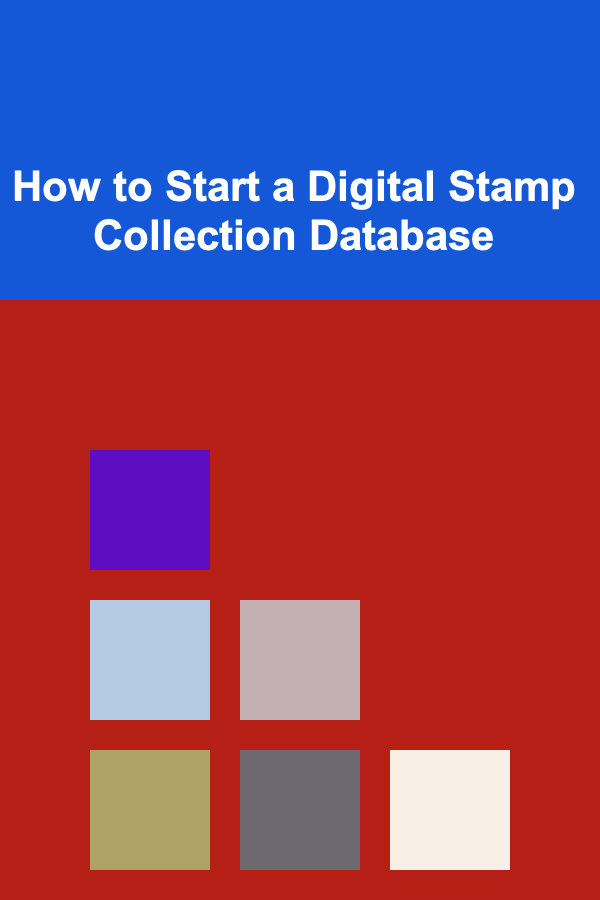
How to Start a Digital Stamp Collection Database
ebook include PDF & Audio bundle (Micro Guide)
$12.99$7.99
Limited Time Offer! Order within the next:

Stamp collecting, also known as philately, has been a popular hobby for centuries. While traditional stamp collecting involves organizing physical stamps into albums or boxes, the digital age has brought about a new way of cataloging and storing these collectibles. Starting a digital stamp collection database is an excellent way to preserve and manage your stamps in an organized, accessible, and secure manner. This guide will walk you through the steps of creating a digital database for your stamp collection, from basic principles to advanced tips for ensuring that your collection is organized and well-maintained.
Why Create a Digital Stamp Collection Database?
Before diving into the technicalities, it's important to understand why you might want to create a digital stamp collection database. Here are several benefits of going digital:
- Organization: A digital database allows for easy sorting and categorization of stamps, making it easier to find any stamp you're looking for without sifting through physical albums.
- Accessibility: You can access your collection from anywhere, whether it's on your phone, tablet, or computer. This is particularly useful when attending stamp shows or communicating with other collectors.
- Security: A digital database protects your collection from physical damage or loss. If anything happens to your stamps, you'll have a backup record of all the items in your collection.
- Growth Tracking: A digital database can help you track the growth of your collection over time. You can easily add new stamps and monitor your acquisitions.
- Easy Sharing: A digital collection is easy to share with other collectors or potential buyers. You can create a digital portfolio that showcases your collection to a wider audience.
With these benefits in mind, let's explore the steps to start a digital stamp collection database.
Decide on Your Database Software
The first step in creating a digital stamp collection database is choosing the right software. There are a variety of tools available that can help you create a database, ranging from simple spreadsheets to specialized philatelic cataloging software. The choice of software depends on the size and complexity of your collection and your budget.
Options to Consider
-
Spreadsheet Programs (Excel, Google Sheets): For beginners, a simple spreadsheet might be all you need to get started. Excel and Google Sheets are highly customizable and free (Google Sheets), allowing you to create your own database with columns for various attributes such as stamp country, year of issue, condition, rarity, and value.
Pros:
- Easy to use.
- Customizable and flexible.
- Free (Google Sheets).
- Compatible with most devices.
Cons:
- Lacks advanced features.
- Requires manual data entry.
- Can become cumbersome as your collection grows.
-
Dedicated Philatelic Software : If you have a larger collection or want more specialized features, dedicated philatelic software may be more appropriate. Programs like StampManage , SageStamp , and iStamp are designed specifically for stamp collectors. These tools provide pre-set fields for cataloging stamps, as well as powerful search and sorting capabilities.
Pros:
- Designed specifically for stamp collections.
- Pre-set categories for easy data entry.
- Advanced features like image storage, barcode scanning, and report generation.
Cons:
- Can be expensive.
- Steeper learning curve.
- Some features may be unnecessary for smaller collections.
-
Custom Database Solutions: For more advanced users, a custom database solution such as Microsoft Access or SQLite can provide complete flexibility. These tools require more technical knowledge but offer the ability to design a database tailored exactly to your needs.
Pros:
- Completely customizable.
- Ideal for very large collections.
- Supports complex queries and reports.
Cons:
- Requires technical knowledge.
- May be overkill for smaller collections.
When choosing the software, consider factors like the size of your collection, your familiarity with database management, and your budget. A spreadsheet might be a good starting point, but if you have a large collection or want advanced features, a dedicated program could be worth the investment.
Categorize Your Stamps
Once you've chosen your software, it's time to categorize your stamps. A well-structured database requires consistent and logical categories. Depending on your collection's focus, there are various ways to categorize your stamps.
Common Categories to Include
- Country of Issue: Group stamps by the country that issued them. This is usually the primary categorization for most collectors.
- Year of Issue: For collectors focused on specific periods or historical eras, categorizing by year can help you track changes over time.
- Type of Stamp: This can include categories such as commemorative, definitive, airmail, or revenue stamps. Some collectors also focus on specific themes, such as animals, transportation, or famous figures.
- Condition: Stamps can be categorized by their physical condition, ranging from mint (unused) to used or heavily damaged. This is an important factor for assessing the stamp's value.
- Rarity and Value: If your collection includes rare stamps, you might want to add a category for rarity or estimated value. Some databases even allow you to link to online catalogs for real-time price updates.
- Album or Collection: If your collection is part of multiple albums or sub-collections, you can create a category for album or collection. This helps you organize stamps based on their physical location as well.
- Size or Type: Stamps can vary in size, and some collectors may prefer to categorize them by physical characteristics like square, rectangular, or oversized stamps.
Optional Categories
- Postmark Type: Some collectors focus on the postmarks or cancellation marks on stamps.
- Special Features: You may also want to include special features like perforation types, watermarking, or printing errors.
- History or Provenance: If you have stamps with unique historical significance or interesting provenance, consider adding notes on these.
The more categories you add, the more detailed and specific your database will be, which is particularly helpful for large collections. However, too many categories can make the database cumbersome, so it's essential to strike the right balance.
Photograph Your Stamps
A digital database becomes much more useful when you include high-quality images of each stamp in your collection. Having photographs allows you to verify the stamp's details visually and ensures that you can easily identify it in the future. It also adds a layer of security by providing evidence of your stamp's condition and appearance.
Tips for Photographing Stamps
- Use a High-Resolution Camera: A good quality camera or smartphone with a high-resolution setting can ensure that you capture the fine details of the stamp.
- Lighting: Proper lighting is essential to avoid shadows and glare. Use natural light or a well-lit room for the best results. You can also invest in a lightbox designed for photographing small objects.
- Close-up Shots: Get as close as possible to capture fine details like perforation patterns, watermarking, or flaws in the printing. Use a macro lens or macro mode on your camera if available.
- Consistency: Keep the background consistent in your photographs. A plain white or neutral background is ideal for stamps, as it helps focus attention on the stamp itself.
- Scan If Possible: If you have access to a scanner, scanning your stamps is often the best way to get a detailed, high-quality image without distortion.
File Management for Images
When adding images to your database, it's important to organize them properly. Use clear and consistent file names to make it easy to locate a specific stamp when needed. For example, you could name the files by the country and year of issue (e.g., "USA_1945_D-Day_Stamp.jpg").
Input Data Into the Database
Now that you have your software and categories set up, and your stamps photographed, it's time to begin entering data into your digital database. Start by inputting basic information about each stamp, including:
- Stamp Name: The title or description of the stamp.
- Country: Where the stamp was issued.
- Year of Issue: The year or range of years when the stamp was released.
- Condition: Whether the stamp is mint, used, or damaged.
- Image: Attach the photo or scanned image of the stamp.
- Catalog Number: If applicable, include a catalog number from a philatelic reference guide like Scott, Stanley Gibbons, or Michel.
- Rarity/Value: Include any estimated value or rarity classification.
As you input the data, you may want to add additional notes, such as the stamp's historical context, notable errors, or its importance in the philatelic community. This information helps make your database a comprehensive record of your collection.
Backup and Maintain Your Database
Once your digital database is up and running, it's crucial to back it up regularly to avoid losing your data. Since a digital database is stored on your computer or in the cloud, it's vulnerable to technical issues, accidental deletions, or even cyberattacks.
Backup Options
- External Hard Drives: Regularly back up your database to an external hard drive or USB drive. This ensures you have a physical copy in case of system failure.
- Cloud Storage: Store your database in the cloud using services like Google Drive, Dropbox, or OneDrive. Cloud storage allows you to access your database from any device and provides automatic backups.
- Redundant Backup: Consider using both cloud and physical backups to ensure the highest level of protection.
Regular Updates
As your collection grows, you'll need to update the database to reflect new acquisitions. You should also review and update the information in the database periodically. For example, the value of stamps can change, and new information or catalog numbers may become available. Regularly checking and maintaining your database ensures that it remains accurate and up-to-date.
Share and Enjoy Your Collection
Once your database is set up, you can enjoy the convenience and accessibility of your digital stamp collection. You can easily share parts of your collection with other collectors, friends, or online philatelic communities. Many collectors use digital databases as a way to display their stamps online, participating in forums, selling or trading stamps, or simply enjoying the process of cataloging their passion.
Conclusion
Creating a digital stamp collection database is an effective way to organize, manage, and protect your stamp collection. By choosing the right software, categorizing your stamps logically, photographing them, and inputting detailed data, you can create a comprehensive record of your collection that is both secure and easily accessible. Regular backups and updates will ensure that your database remains accurate and reliable. With your stamps digitally cataloged, you'll be able to enjoy your collection with greater ease and share it with others more effectively.
Starting a digital stamp collection database might require an investment of time and effort upfront, but the long-term benefits are undeniable. Whether you're a beginner collector or a seasoned philatelist, going digital will help you take your passion for stamps to the next level.
Reading More From Our Other Websites
- [Personal Investment 101] How to Use Peer-to-Peer Lending for Higher Returns
- [Small Business 101] Best Ways to Leverage TikTok for Small‑Scale Home Décor Businesses
- [Home Security 101] How to Improve Home Security While You're on Vacation
- [Home Storage Solution 101] How to Tidy Up Your Bedroom with Simple Storage Solutions
- [Personal Finance Management 101] How to Save Money on Groceries While Eating Healthily
- [Trail Running Tip 101] Nutrition Strategies on the Trail: Fueling Your Race from Start to Finish
- [Home Security 101] How to Choose the Right Locks for Your Home
- [Home Lighting 101] How to Enhance Your Outdoor Living Area with Outdoor Lighting
- [Reading Habit Tip 101] The Ultimate Book-Club Challenge: Read Across Genres in 12 Weeks
- [Home Party Planning 101] How to Plan a Retro 80s Party That's Totally Rad!

How to Budget for New Furniture and Home Decor Purchases
Read More
How to Incorporate Plants into Your Bathroom Organization
Read More
How To Photograph Fireworks Safely
Read More
How to Develop Your World-Building Details
Read More
How to Develop Regulation-Compliant Blockchain Solutions
Read More
How to Conduct Effective Workplace Risk Assessments
Read MoreOther Products

How to Budget for New Furniture and Home Decor Purchases
Read More
How to Incorporate Plants into Your Bathroom Organization
Read More
How To Photograph Fireworks Safely
Read More
How to Develop Your World-Building Details
Read More
How to Develop Regulation-Compliant Blockchain Solutions
Read More